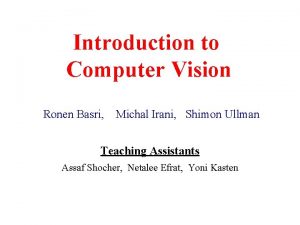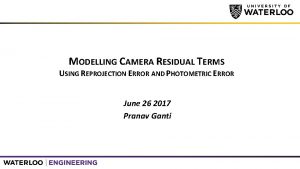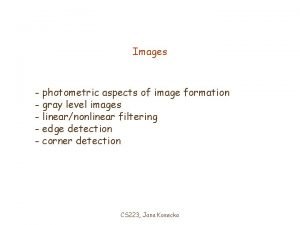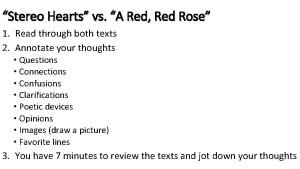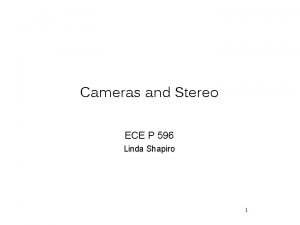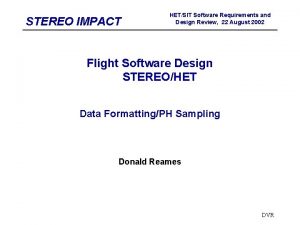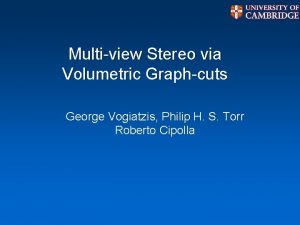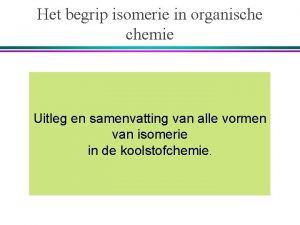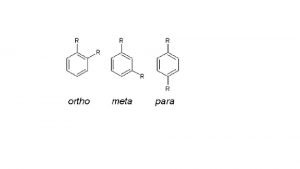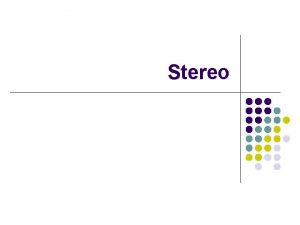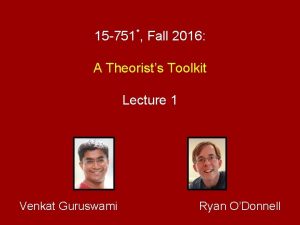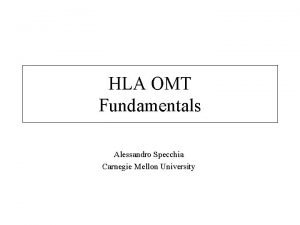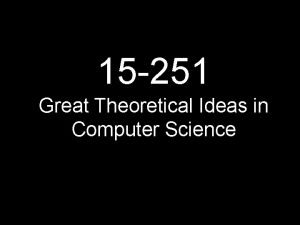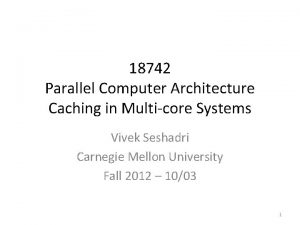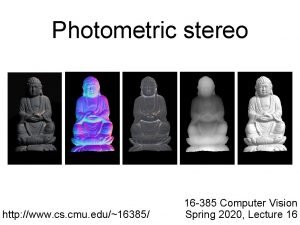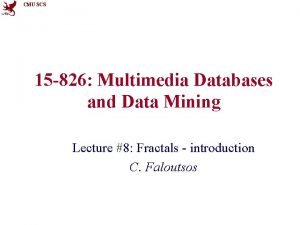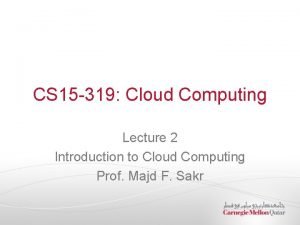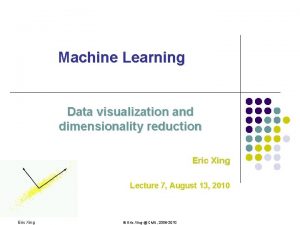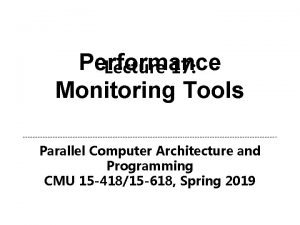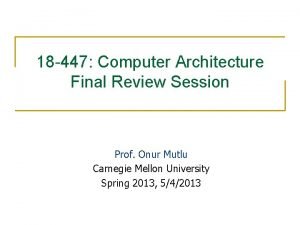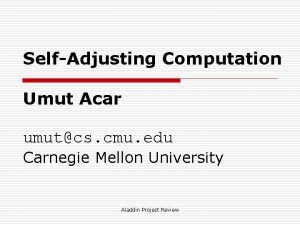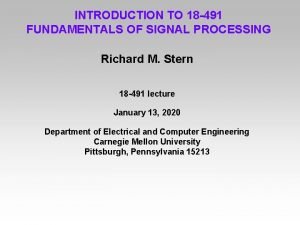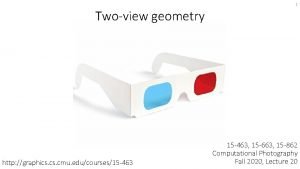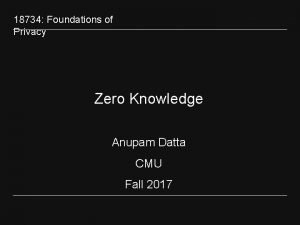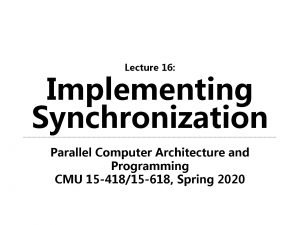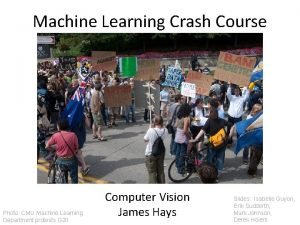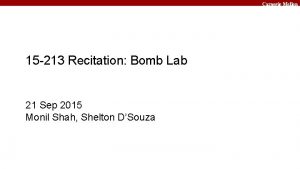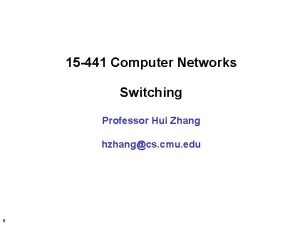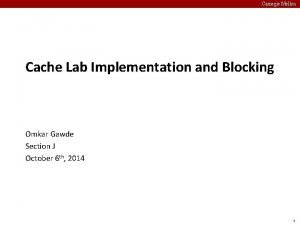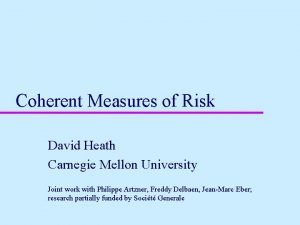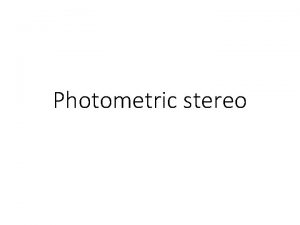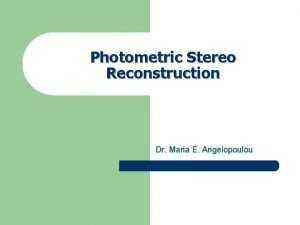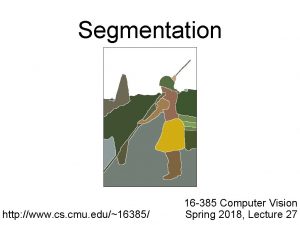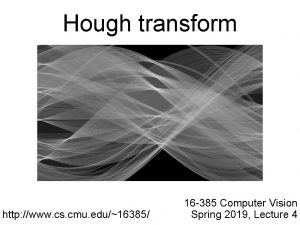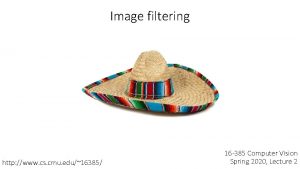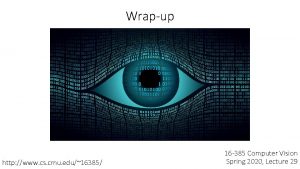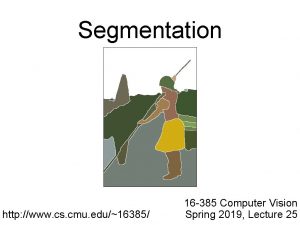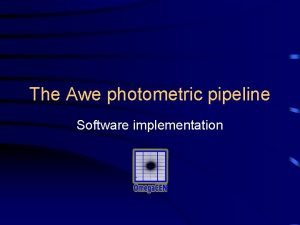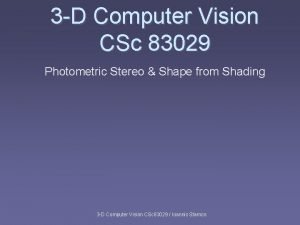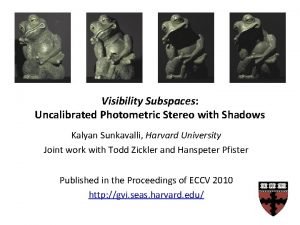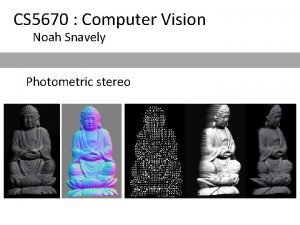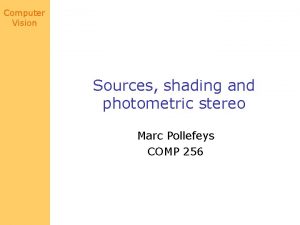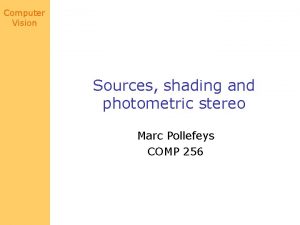Photometric stereo http www cs cmu edu16385 16
















































































![Shape independent of BRDF via reciprocity: “Helmholtz Stereopsis” [Zickler et al. , 2002] Shape independent of BRDF via reciprocity: “Helmholtz Stereopsis” [Zickler et al. , 2002]](https://slidetodoc.com/presentation_image_h/9384a740d967c6265474b48f249c1451/image-81.jpg)

![Single-lighting is ambiguous ASSUMPTION 1: LAMBERTIAN ASSUMPTION 2: DIRECTIONAL LIGHTING [Prados, 2004] Single-lighting is ambiguous ASSUMPTION 1: LAMBERTIAN ASSUMPTION 2: DIRECTIONAL LIGHTING [Prados, 2004]](https://slidetodoc.com/presentation_image_h/9384a740d967c6265474b48f249c1451/image-83.jpg)









- Slides: 92

Photometric stereo http: //www. cs. cmu. edu/~16385/ 16 -385 Computer Vision Spring 2019, Lecture 15

Course announcements • Homework 4 has been posted tonight and is due on March 27 th. - How many of you have looked at/started/finished the homework? - Any questions? • How many of you attended Jun-Yan Zhu talk? • Another talk tomorrow: Angjoo Kanazawa, “Perceiving Humans in the 3 D World, ” 10 -11 am, GHC 6115

Overview of today’s lecture • Leftover about light sources. • Some notes about radiometry. • Photometric stereo. • Uncalibrated photometric stereo. • Generalized bas-relief ambiguity. • Shape from shading. • Start image processing pipeline.

Slide credits Many of these slides were adapted from: • Srinivasa Narasimhan (16 -385, Spring 2014). • Todd Zickler (Harvard University). • Steven Gortler (Harvard University). • Kayvon Fatahalian (Stanford University; CMU 15 -462, Fall 2015).

Some notes about radiometry

What about color?

Spectral radiance • Distribution of radiance as a function of wavelength. • All of the phenomena we described in this lecture can be extended to take into account color, by considering separate radiance and BRDF functions independently for each wavelength. retinal color spectral radiance spectral reflectance illuminant spectrum

Spectral radiance • Distribution of radiance as a function of wavelength. • All of the phenomena we described in this lecture can be extended to take into account color, by considering separate radiance and BRDF functions independently for each wavelength. Does this view of color ignore any important phenomena?

Spectral radiance • Distribution of radiance as a function of wavelength. • All of the phenomena we described in this lecture can be extended to take into account color, by considering separate radiance and BRDF functions independently for each wavelength. Does this view of color ignore any important phenomena? • Things like fluorescence and any other phenomena where light changes color.

Spectral Sensitivity Function (SSF) • Any light sensor (digital or not) has different sensitivity to different wavelengths. • This is described by the sensor’s spectral sensitivity function . • When measuring light of a some SPD , the sensor produces a scalar response: light SPD sensor SSF sensor response Weighted combination of light’s SPD: light contributes more at wavelengths where the sensor has higher sensitivity. The spectral sensitivity function converts radiometric units (radiance, irradiance) defined per wavelength, to radiometric quantities where wavelength has been averaged out.

Radiometry versus photometry

Radiometry versus photometry

Radiometry versus photometry


Quiz 1: Measurement of a sensor using a thin lens What integral should we write for the power measured by infinitesimal pixel p?

Quiz 1: Measurement of a sensor using a thin lens What integral should we write for the power measured by infinitesimal pixel p? Can I transform this integral over the hemisphere to an integral over the aperture area?

Quiz 1: Measurement of a sensor using a thin lens What integral should we write for the power measured by infinitesimal pixel p? Can I transform this integral over the hemisphere to an integral over the aperture area?

Quiz 1: Measurement of a sensor using a thin lens Can I write the denominator in a more convenient form?

Quiz 1: Measurement of a sensor using a thin lens What does this say about the image I am capturing?

Vignetting Fancy word for: pixels far off the center receive less light white wall under uniform light Four types of vignetting: more interesting example of vignetting • Mechanical: light rays blocked by hoods, filters, and other objects. • Lens: similar, but light rays blocked by lens elements. • Natural: due to radiometric laws (“cosine fourth falloff”). • Pixel: angle-dependent sensitivity of photodiodes.

Quiz 2: BRDF of the moon What BRDF does the moon have?

Quiz 2: BRDF of the moon What BRDF does the moon have? • Can it be diffuse?

Quiz 2: BRDF of the moon What BRDF does the moon have? • Can it be diffuse? Even though the moon appears matte, its edges remain bright.

Rough diffuse appearance

Five important equations/integrals to remember Flux measured by a sensor of area X and directional receptivity W: Reflectance equation: Radiance under directional lighting and Lambertian BRDF (“n-dot-l shading”): Conversion of a (hemi)-spherical integral to a surface integral: Computing (hemi)-spherical integrals: and

Photometric stereo

Image Intensity and 3 D Geometry • Shading as a cue for shape reconstruction • What is the relation between intensity and shape?

“N-dot-l” shading ASSUMPTION 1: LAMBERTIAN ASSUMPTION 2: DIRECTIONAL LIGHTING Why do we call these normal “shape”?

z Surfaces and normals imaged surface viewing rays for different pixels x what is a camera like this called?

z Surfaces and normals imaged surface Surface representation as a depth field (also known as Monge surface): viewing rays for different pixels pixel coordinates on image place depth at each pixel x orthographic camera How does surface normal relate to this representation?

z Surfaces and normals imaged surface Surface representation as a depth image (also known as Monge surface): viewing rays for different pixels pixel coordinates on image place depth at each pixel Unnormalized normal: x orthographic camera Actual normal: Normals are scaled spatial derivatives of depth image!

Shape from a Single Image? • Given a single image of an object with known surface reflectance taken under a known light source, can we recover the shape of the object?

Human Perception

Examples of the classic bump/dent stimuli used to test lighting assumptions when judging shape from shading, with shading orientations (a) 0° and (b) 180° from the vertical. Thomas R et al. J Vis 2010; 10: 6

Human Perception • Our brain often perceives shape from shading. • Mostly, it makes many assumptions to do so. • For example: Light is coming from above (sun). Biased by occluding contours. by V. Ramachandran

Single-lighting is ambiguous ASSUMPTION 1: LAMBERTIAN ASSUMPTION 2: DIRECTIONAL LIGHTING

Lambertian photometric stereo Assumption: We know the lighting directions.

Lambertian photometric stereo define “pseudo-normal” solve linear system for pseudo-normal What are the dimensions of these matrices?

Lambertian photometric stereo define “pseudo-normal” solve linear system for pseudo-normal What are the knowns and unknowns?

Lambertian photometric stereo define “pseudo-normal” solve linear system for pseudo-normal How many lights do I need for unique solution?

Lambertian photometric stereo define “pseudo-normal” solve linear system for pseudo-normal How do we solve this system? once system is solved, b gives normal direction and albedo

Solving the Equation with three lights inverse Is there any reason to use more than three lights?

More than Three Light Sources • Get better SNR by using more lights • Least squares solution: • Solve for as before Moore-Penrose pseudo inverse

Computing light source directions • Trick: place a chrome sphere in the scene – the location of the highlight tells you the source direction

Limitations • Big problems – Doesn’t work for shiny things, semi-translucent things – Shadows, inter-reflections • Smaller problems – Camera and lights have to be distant – Calibration requirements • • measure light source directions, intensities camera response function

Depth from normals • Solving the linear system per-pixel gives us an estimated surface normal for each pixel Input photo Estimated normals (needle diagram) • How can we compute depth from normals? • Normals are like the “derivative” of the true depth

z Surfaces and normals imaged surface Surface representation as a depth image (also known as Monge surface): viewing rays for different pixels pixel coordinates in image space depth at each pixel Unnormalized normal: x orthographic camera Actual normal: Normals are scaled spatial derivatives of depth image!

Normal Integration • Integrating a set of derivatives is easy in 1 D • (similar to Euler’s method from diff. eq. class) • Could just integrate normals in each column / row separately • Instead, we formulate as a linear system and solve for depths that best agree with the surface normals

Depth from normals V 2 V 1 N Get a similar equation for V 2 • Each normal gives us two linear constraints on z • compute z values by solving a matrix equation

Results 1. 2. 3. 4. 5. Estimate light source directions Compute surface normals Compute albedo values Estimate depth from surface normals Relight the object (with original texture and uniform albedo)

Results: Lambertian Sphere Input Images Needles are projections of surface normals on image plane Estimated Surface Normals Estimated Albedo

Lambertain Mask

Results – Albedo and Surface Normal

Results – Shape of Mask

Results: Lambertian Toy I. 2 Input Images Estimated Surface Normals Estimated Albedo

Non-idealities: interreflections

Non-idealities: interreflections Shallow reconstruction (effect of interreflections) Accurate reconstruction (after removing interreflections)

What if the light directions are unknown?

Uncalibrated photometric stereo

What if the light directions are unknown? define “pseudo-normal” solve linear system for pseudo-normal

What if the light directions are unknown? define “pseudo-normal” solve linear system for pseudo-normal at each image pixel M: number of pixels

What if the light directions are unknown? define “pseudo-normal” solve linear system for pseudo-normal at each image pixel How do we solve this system without knowing light matrix L?

Factorizing the measurement matrix Lights Pseudonormals What are the dimensions?

Factorizing the measurement matrix • Singular value decomposition: This decomposition minimizes |I-LB|2

Are the results unique?

Are the results unique? We can insert any 3 x 3 matrix Q in the decomposition and get the same images: I = L B = (L Q-1) (Q B)

Are the results unique? We can insert any 3 x 3 matrix Q in the decomposition and get the same images: I = L B = (L Q-1) (Q B) Can we use any assumptions to remove some of these 9 degrees of freedom?

Generalized bas-relief ambiguity

Enforcing integrability What does the matrix B correspond to?

Enforcing integrability What does the matrix B correspond to? • Surface representation as a depth image (also known as Monge surface): depth at each pixel • Unnormalized normal: pixel coordinates in image space • Actual normal: • Pseudo-normal: • Rearrange into 3 x. N matrix B.

Enforcing integrability What does the integrability constraint correspond to?

Enforcing integrability What does the integrability constraint correspond to? • Differentiation order should not matter: • Can you think of a way to express the above using pseudo-normals b?

Enforcing integrability What does the integrability constraint correspond to? • Differentiation order should not matter: • Can you think of a way to express the above using pseudo-normals b?

Enforcing integrability What does the integrability constraint correspond to? • Differentiation order should not matter: • Can you think of a way to express the above using pseudo-normals b? • Simplify to:

Enforcing integrability What does the integrability constraint correspond to? • Differentiation order should not matter: • Can you think of a way to express the above using pseudo-normals b? • Simplify to: • If Be is the pseudo-normal matrix we get from SVD, then find the 3 x 3 transform D such that B=D⋅Be is the closest to satisfying integrability in the least-squares sense.

Enforcing integrability Does enforcing integrability remove all ambiguities?

Generalized Bas-relief ambiguity • Combined with transformed lights S’=G⋅S, the transformed pseudonormals produce the same images as the original pseudonormals. • This ambiguity cannot be removed using shadows. • This ambiguity can be removed using interreflections or additional assumptions. This ambiguity is known as the generalized bas-relief ambiguity.

Generalized Bas-relief ambiguity Otherwise, includes shearing.

What assumptions have we made for all this?

What assumptions have we made for all this? • Lambertian BRDF • Directional lighting • No interreflections or scattering
![Shape independent of BRDF via reciprocity Helmholtz Stereopsis Zickler et al 2002 Shape independent of BRDF via reciprocity: “Helmholtz Stereopsis” [Zickler et al. , 2002]](https://slidetodoc.com/presentation_image_h/9384a740d967c6265474b48f249c1451/image-81.jpg)
Shape independent of BRDF via reciprocity: “Helmholtz Stereopsis” [Zickler et al. , 2002]

Shape from shading
![Singlelighting is ambiguous ASSUMPTION 1 LAMBERTIAN ASSUMPTION 2 DIRECTIONAL LIGHTING Prados 2004 Single-lighting is ambiguous ASSUMPTION 1: LAMBERTIAN ASSUMPTION 2: DIRECTIONAL LIGHTING [Prados, 2004]](https://slidetodoc.com/presentation_image_h/9384a740d967c6265474b48f249c1451/image-83.jpg)
Single-lighting is ambiguous ASSUMPTION 1: LAMBERTIAN ASSUMPTION 2: DIRECTIONAL LIGHTING [Prados, 2004]

Stereographic Projection (p, q)-space (gradient space) Problem (p, q) can be infinite when Redefine reflectance map as (f, g)-space

Image Irradiance Constraint • Image irradiance should match the reflectance map Minimize (minimize errors in image irradiance in the image)

Smoothness Constraint • Used to constrain shape-from-shading • Relates orientations (f, g) of neighboring surface points Minimize : surface orientation under stereographic projection (penalize rapid changes in surface orientation f and g over the image)

Shape-from-Shading • Find surface orientations (f, g) at all image points that minimize weight smoothness constraint image irradiance error Minimize

Numerical Shape-from-Shading • Smoothness error at image point (i, j) Of course you can consider more neighbors (smoother results) • Image irradiance error at image point (i, j) Find and that minimize (Ikeuchi & Horn 89)

Results

Results

More modern results

References Basic reading: • Szeliski, Section 2. 2. • Gortler, Chapter 21. This book by Steven Gortler has a great introduction to radiometry, reflectance, and their use for image formation. Additional reading: • Oren and Nayar, “Generalization of the Lambertian model and implications for machine vision, ” IJCV 1995. The paper introducing the most common model for rough diffuse reflectance. • Debevec, “Rendering Synthetic Objects into Real Scenes, ” SIGGRAPH 1998. The paper that introduced the notion of the environment map, the use of chrome spheres for measuring such maps, and the idea that they can be used for easy rendering. • Lalonde et al. , “Estimating the Natural Illumination Conditions from a Single Outdoor Image, ” IJCV 2012. A paper on estimating outdoors environment maps from just one image. • Basri and Jacobs, “Lambertian reflectance and linear subspaces, ” ICCV 2001. • Ramamoorthi and Hanrahan, “A signal-processing framework for inverse rendering, ” SIGGRAPH 2001. • Sloan et al. , “Precomputed radiance transfer for real-time rendering in dynamic, low-frequency lighting environments, ” SIGGRAPH 2002. Three papers describing the use of spherical harmonics to model low-frequency illumination, as well as the low-pass filtering effect of Lambertian reflectance on illumination. • Zhang et al. , “Shape-from-shading: a survey, ” PAMI 1999. A review of perceptual and computational aspects of shape from shading. • Woodham, “Photometric method for determining surface orientation from multiple images, ” Optical Engineering 1980. The paper that introduced photometric stereo. • Yuille and Snow, “Shape and albedo from multiple images using integrability, ” CVPR 1997. • Belhumeur et al. , “The bas-relief ambiguity, ” IJCV 1999. • Papadhimitri and Favaro, “A new perspective on uncalibrated photometric stereo, ” CVPR 2013. Three papers discussing uncalibrated photometric stereo. The first paper shows that, when the lighting directions are not known, by assuming integrability, one can reduce unknowns to the bas-relief ambiguity. The second paper discusses the bas-relief ambiguity in a more general context. The third paper shows that, if instead of an orthographic camera one uses a perspective camera, this is further reduced to just a scale ambiguity. • Alldrin et al. , “Resolving the generalized bas-relief ambiguity by entropy minimization, ” CVPR 2007. A popular technique for resolving the bas-relief ambiguity in uncalibrated photometric stereo. • Zickler et al. , “Helmholtz stereopsis: Exploiting reciprocity for surface reconstruction, ” IJCV 2002. A method for photometric stereo reconstruction under arbitrary BRDF. • Nayar et al. , “Shape from interreflections, ” IJCV 1991. • Chandraker et al. , “Reflections on the generalized bas-relief ambiguity, ” CVPR 2005. Two papers discussing how one can perform photometric stereo (calibrated or otherwise) in the presence of strong interreflections. • Frankot and Chellappa, “A method for enforcing integrability in shape from shading algorithms, ” PAMI 1988. • Agrawal et al. , “What is the range of surface reconstructions from a gradient field? , ” ECCV 2006. Two papers discussing how one can integrate a normal field to reconstruct a surface.
 Lun shape
Lun shape Ronen basri
Ronen basri Photometric reprojection error
Photometric reprojection error Photometric image formation
Photometric image formation Geometric and photometric image formation
Geometric and photometric image formation Simile in stereo hearts
Simile in stereo hearts Stereo
Stereo Faux poe the lighter side of gothic poetry answer key
Faux poe the lighter side of gothic poetry answer key Please clean the blackboard
Please clean the blackboard Stereo
Stereo Stereo science center
Stereo science center Cis trans isomerie
Cis trans isomerie Hetsit
Hetsit Multiview stereo
Multiview stereo Stereo luz tehuacán
Stereo luz tehuacán Asymmetrische koolstofatomen
Asymmetrische koolstofatomen Hyperbole in stereo hearts
Hyperbole in stereo hearts Would you mind turning the radio down
Would you mind turning the radio down Tcp stereo
Tcp stereo Stereo isomeria
Stereo isomeria Would you mind ____ the window?
Would you mind ____ the window? Singular to plural words
Singular to plural words Fusion stereo problems
Fusion stereo problems Http //mbs.meb.gov.tr/ http //www.alantercihleri.com
Http //mbs.meb.gov.tr/ http //www.alantercihleri.com Siat.ung.ac.id krs
Siat.ung.ac.id krs Stephen smith cmu
Stephen smith cmu Cmu 16-385
Cmu 16-385 Cmu 15-751
Cmu 15-751 Cmu fom
Cmu fom Cmu two factor authentication
Cmu two factor authentication Great theoretical ideas in computer science
Great theoretical ideas in computer science 18742 cmu
18742 cmu Brad myers cmu
Brad myers cmu Cmu 15-213
Cmu 15-213 Cmu 16385
Cmu 16385 Cmu
Cmu Malloc lab cmu
Malloc lab cmu Cmu cladding
Cmu cladding Carnegie mellon
Carnegie mellon Cmu cloud computing
Cmu cloud computing David garlan cmu
David garlan cmu Cmu immunization
Cmu immunization Zack weinberg cmu
Zack weinberg cmu Cmu 14848
Cmu 14848 Lle algorithm
Lle algorithm Cmu 15-418
Cmu 15-418 Bomb lab secret phase
Bomb lab secret phase Cmu machine learning
Cmu machine learning Fces
Fces Ghc cmu
Ghc cmu Cmu speech recognition
Cmu speech recognition Canvas cmu
Canvas cmu Cmu robotics minor
Cmu robotics minor Cmu library
Cmu library Anthony rowe cmu
Anthony rowe cmu Cmu malloc lab
Cmu malloc lab Data mining cmu
Data mining cmu Self adjusting computation
Self adjusting computation 15-440 cmu
15-440 cmu Richard stern cmu
Richard stern cmu Cmu sio
Cmu sio Vyas sekar
Vyas sekar Eric xing cmu
Eric xing cmu Kesden cmu
Kesden cmu Triangulation
Triangulation Eric xing
Eric xing Rowena mittal
Rowena mittal 15-213 cmu
15-213 cmu 18734 cmu
18734 cmu Canvas cmu
Canvas cmu Carnegie mellon vpn
Carnegie mellon vpn 18-213 cmu
18-213 cmu Vanessa branch cmu
Vanessa branch cmu Healthconnect cmu
Healthconnect cmu Shell lab cmu
Shell lab cmu Vmwaare cmu
Vmwaare cmu Tom cortina cmu
Tom cortina cmu Ryan o'donnell cmu
Ryan o'donnell cmu Cmu mld
Cmu mld Parallel computer architecture cmu
Parallel computer architecture cmu Cmu machine learning
Cmu machine learning 14848 cmu
14848 cmu Bibliothèque cmu
Bibliothèque cmu 15213 bomb lab
15213 bomb lab Chris atkeson cmu
Chris atkeson cmu Hui zhang cmu
Hui zhang cmu Cache lab part b
Cache lab part b Cmu rapid prototyping
Cmu rapid prototyping Assembly bomb lab
Assembly bomb lab Cmu data mining
Cmu data mining Self.cmu.ac.ir
Self.cmu.ac.ir Ryan o'donnell cmu
Ryan o'donnell cmu David eber cmu
David eber cmu

